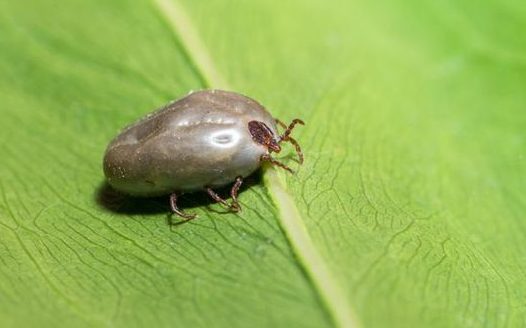
The Beginning of the End
A Masterstroke of Economic and Geopolitical Brilliance


A newly discovered invasive tick, most commonly found in Asia and known for cloning itself, spreading diseases in humans and sucking livestock dry has been discovered in the United States. Native to East Asia, the longhorn tick is known for spreading diseases in humans that can be fatal.
An Entomologist at the Hunterdon County Health Services in Flemington, New Jersey says he’s never seen anything quite like this new tick infestation on a pet sheep. In September of 2017, Tadhgh Rainey noticed the strange ticks after a farmer came into the facility covered in them. She said she was shearing her one sheep when she noticed they had covered her. According to Science News, when he and his colleague entered the sheep’s enclosure, “we almost immediately got covered in ticks,” he says. “I couldn’t believe this sheep was alive.” It was covered in hundreds, maybe thousands, of ticks.” The entire investigation sounds like something straight out of a horror movie:
“Investigation of the Hunterdon property in early October revealed a large number of ticks both on the sheep and throughout the paddock,” the scientists shared in a new study published in the Journal of Medical Entomology. “The ticks in the paddock were so numerous that they crawled on investigators’ pants soon after setting foot inside. The sheep was supporting hundreds of ticks, including all three active life stages (larva, nymph, adult). Although ticks were concentrated on the sheep’s ears and face, engorged ticks of all stages were readily found all over its body, including areas beneath the animal’s thick coat.” –Mother Nature Network
Rainey couldn’t identify the ticks swarming all over his body, so he sent several samples to labs all across the country. One went to Andrea Egizi, an entomologist at Rutgers School of Environmental and Biological Sciences in New Brunswick, N.J. When Egizi analyzed the DNA of the ticks she was shocked and horrified when the identification came back as Haemaphysalis longicornis, a native of East Asia, known as the “Longhorn Tick.”
“There were no other domestic animals on that property, so it’s a really big mystery exactly how it got there,” Andrea Egizi, the senior author of a paper on the discovery published last week in the Journal of Medical Entomology, told NPR. And now, the tick comfortably calls New Jersey its home. The New Jersey Department of Agriculture announced in early May that the longhorn tick, a species native to China, Japan, and Australia has successfully survived the New Jersey winter and will likely be spreading throughout the state.
The tick spends winters burrowed underground in order to survive. Besides its ability to burrow underground to avoid death from freezing temperatures, the longhorn tick also has some other characteristics that put a frightening and horrifying spin on its discovery. The tick reproduces asexually and rapidly increasing in population by cloning itself and laying thousands of eggs. The nymphs and adults also tend to “swarm” their prey, with recorded observations of hundreds of ticks hanging from their hosts like “bunches of grapes.”
“Only one tick is needed to start a population, and they can grow to high numbers quickly,” Egizi who is the senior author on the report, told Entomology Today. “They are not limited by the need to find mates, which can be difficult in a small population.” The longhorn tick will also suck the blood of any bird or mammal it can get its hooks into, including humans meaning it has the potential to spread fatal diseases. Of particular concern to scientists and health officials is obviously Lyme disease, but other potentially fatal diseases that cause neurological problems are also worrying, including ehrlichiosis, anaplasmosis, Rocky Mountain spotted fever and Powassan virus. Recently, the longhorn tick has been linked to a disease called “severe fever with thrombocytopenia syndrome” (SFTS), which causes severe hemorrhaging and has a mortality rate of more than 5 percent.
Farmers should keep an eye on their animals as well and keep up with tick treatments. At least for now, it seems cows and sheep should be more afraid of this invasive tick than people. The longhorn tick is great at transmitting the deadly cattle disease theileriosis and heavy infestations of the ticks have also been known to suck so much blood from a single animal that it dies, a vampiric practice called exsanguination. Meaning the ticks sucked the animal’s blood dry.

It Took 22 Years to Get to This Point
The Trump Administration has cancelled the $766 million contract with Moderna to develop an mRNA...
This article was originally published by Michael Snyder at The Economic Collapse Blog. How are...
The West has lifted its restrictions on Kiev's use of long-range missiles against Russia in the...
This article was originally published by Ava Grace at Natural News. Eighty-eight percent of...
Commenting Policy:
Some comments on this web site are automatically moderated through our Spam protection systems. Please be patient if your comment isn’t immediately available. We’re not trying to censor you, the system just wants to make sure you’re not a robot posting random spam.
This website thrives because of its community. While we support lively debates and understand that people get excited, frustrated or angry at times, we ask that the conversation remain civil. Racism, to include any religious affiliation, will not be tolerated on this site, including the disparagement of people in the comments section.


Don’t know how it got here?
Looks like they are trying EVERYTHING to get diseases spread.
It will only be a short time before they start running for public office.
I’ve only had one tick on me once after walking in the Ocala National Forest in the past. I pulled it off my stomach and that was that. The bite spot lingered but finally went away. Once stayed in California, the black widow spiders were everywhere in the house and in the garage, never hear about those spiders biting people so maybe the danger is overblown. After driving back down south the black widows were under the car and quickly multiplied out on the screen porch. I thought they were dry non humid weather spiders. With all of the Asians coming to America the people or goods shipped bring the invasive species with them. Big non native snakes down in the Everglades are eating good sized alligators.
Oh, it’s a bug. I thought the article was going to be about all of our two-legged ‘guests’.
If you can afford to buy a large freezer and fill it with meat you might avoid paying higher prices later on, because this little bug could be the beginning of the end of our access to somewhat affordable meat.
Whether we’re being intentionally targeted by Asia or others, or this is just the result of our importing of goods and people, regardless, it is concerning.
_
Sucks Livestock Dry While Spreading Diseases…..sounds like a liberal.
Looks like another thing to keep an eye on. I hope the winter did it in…it was much colder than usual in the east.
Also, this is a good lesson on checking on your animals whether livestock or pets. A monthly visual check of ears, eyes, feet, etc. can catch problems while easy to fix.
I would question how it got brought over here. Spreading nematodes in the grass and nearby brush could help prevent flea and ticks from spreading.